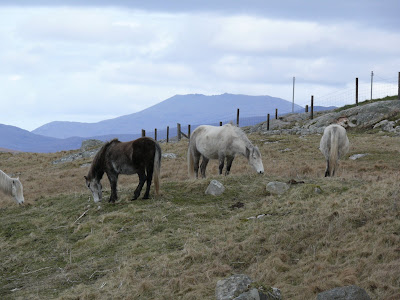 ERISKAY TO BARRA FERRY
ERISKAY TO BARRA FERRYI love these little roll on roll off ferries. This one takes just 40 minutes to sail between Barra and Eriskay and operates several times a day throughout the year. When the weather is good, the views are spectacular. Apart from a variety of sea birds, there is always a good chance of spotting seals, porpoises, dolphins, basking sharks and the occasional whale.
Have spent the last two weeks at home, on holiday, starting to decorate the house with a friend. We've achieved a lot and now have three rooms, including the kitchen, almost habitable. There's something very satisfying about starting with bare plaster and concrete and watching it take shape and colour.It all takes a long time though and I think it will be well into the Autumn before I'm finished. The tiler is now working regularly, but the electrician has not yet returned to wire up the cooker and shed. The TV aerial man popped in two weeks ago to decide what bits of kit he needed to make my television work and I've not seen him since. There is still a problem with the installation of the wood burning stove, which I am hoping will be finally fitted tomorrow. On the positive side, the building inspector has been and approved the general quality of the work done so far. As soon as the electricians have finished, I should get the much needed completion certificate.
The house access track, which is about 120 yards long, is in appalling condition, having had little or no maintenance for many years. Any vehicle coming to the house, including my own, is in dire danger of having its sump and exhaust pipe ripped off because of holes, ruts, dips and slopes. Trying to get from the public road to the house is like negotiating a minefield and I wince every time I manage to hit an unseen rock. Can't bring myself to take a look at the underside of the car. In winter, the track is largely under water and the car has to swim through. Last year, I bought fifteen tons of roadstone from the local quarry in an attempt to patch the road and avoid the day when it would finally have to be rebuilt. Unfortunately, all my efforts with a wheelbarrow, and those of friends recruited to the chain gang, have had little effect. Three builder's lorries a day for the last six months, and the odd passing oil tanker, have now made the track almost impassable. After much keening, wailing and knashing of teeth, I've decided to have the track relaid professionally. When the last tradesman leaves, waving his handkerchief and with a tear in his eye, the road contractor is going to arrive to re lay the track and improve the drainage at the front of the croft. That work should be done before the end of the summer and is likely to ensure that I have to continue working full time until I'm about 78. So much for plans to wander round the ranch doing little but waving a shepherd's crook and tending the sheep. Still, mustn't grumble.
The recent wonderful weather has produced an explosion of flowers on the croft. Swathes of cotton grass appeared almost overnight at the front of the house and look wonderful swaying in the wind. Down towards the loch, the thrift has just finished flowering on the rock face, but there are now dozens of spotted orchids in full bloom on the slope at the West end of the croft. There are lots of as yet unidentified tiny yellow and blue flowers and I'm hoping to find the carnivorous sundew in the bog in the next week or two. These are amazing plants, like venus fly traps, which trap and digest small insects. There were thousands of them last year, so I'm hoping for a repeat performance this summer.
A former colleague from the South is coming to stay for a couple of days from tomorrow. He's a keen birdwatcher and is currently visiting North Uist, searching for a Snowy Owl, which is preening and displaying itself on fenceposts in Grenitote village, even as we speak. This bird, and another Snowy Owl, have been regular visitors in recent years and there is some hope that they will settle down together and breed here. Someone, presumably, has worked out that they are male and female, otherwise it's going to be a long wait. I have been chasing round the Hebrides for the last two years looking to see a Snowy Owl, but it's always flown away by the time I get there and I still haven't seen one in the flesh. Can't spare the time to go to Uist just now, but will be working there in a couple of weeks, so maybe it will wait for me.
Incidentally, the RSPB have set up an Eagle Watch for members at a small quarry in Griminish, North Uist. They have powerful telescopes focussed on the nest of a pair of Golden Eagles about half a mile away. The watch is being made available every Thursday evening from May 15, until any chicks have fledged and flown. For further details, contact Jamie Boyle, RSPB warden, on 01876 560287, or at Jamie.Boyle@rspb.org.uk.
There are currently about twenty sheep and lambs being grazed at the back of the house and consequently, an increase in ravens searching opportunistically for casualties. My neighbour, who owns the sheep, has brought round a carcass of lamb, produced on this croft, which is now nestling coldly in the freezer. This is payment for the grazing and as I try not to eat too much meat, is likely to last a while.
